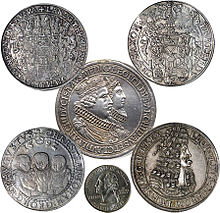
The Thaler (or Taler or Talir) was a silver coin used throughout Europe for almost four hundred years. Its name lives on in various currencies as the dollar or tolar. Etymologically, “Thaler” is an abbreviation of “Joachimsthaler”, a coin type from the city of Joachimsthal (Jáchymov) in Bohemia, where some of the first such coins were minted in 1518. (Thal is German for “dale” or “dell”; they all mean “valley”. Therefore a “thaler” is a person or a thing “from the valley”. In 1902, the official spelling was changed from Thal to Tal. The English version does not reflect this change.)
The roots and development of the Thaler-sized silver coin date back to the mid-15th century. As the 15th century drew to a close the state of much of Europe’s coinage was quite poor because of repeated debasement induced by the costs of continual warfare, and by the incessant centuries-long loss of silver and gold in indirect one-sided trades importing spices and porcelain and silk and other fine cloths and exotic goods from India, Indonesia and the Far East. This continual debasement had reached a point that silver content in Groschen-type coins had dropped, in some cases, to less than five percent, making the coins of much less individual value than they had in the beginning.
Countering this trend, with the discovery and mining of silver deposits in Europe, Italy began the first tentative steps toward a large silver coinage with the introduction in 1472 of the lira tron in excess of six grams, a substantial increase over the, roughly, four-gram gros tournois of France.

In 1474 a nine-gram lira was issued but it was in 1484 that Archduke Sigismund of Tirol issued the first truly revolutionary silver coin, the half Guldengroschen of roughly 15½ (fifteen and a half) grams. This was a very rare coin, almost a trial piece, but it did circulate so successfully that demand could not be met.
Finally, with the silver deposits—being mined at Schwaz—to work with and his mint at Hall, Sigismund issued, in 1486, large numbers of the first true Thaler-sized coin, the Guldengroschen (great gulden, being of silver but equal in value to a Goldgulden).
The Guldengroschen, nicknamed the guldiner, was an instant and unqualified success. Soon it was being copied widely by many states who had the necessary silver. The engravers, no less affected by the Renaissance than were other artists, began creating intricate and elaborate designs featuring the heraldic arms and standards of the minting state as well as brutally realistic, sometimes unflattering, depictions of the ruler (monarch).
Where did it all start?
The Sumerian civilization developed a large scale economy based on commodity money. The Babylonians and their neighboring city states later developed the earliest system of economics as we think of it today, in terms of rules on debt, legal contracts and law codes relating to business practices and private property.[5][6]
The Code of Hammurabi, the best preserved ancient law code, was created ca. 1760 BC (middle chronology) in ancient Babylon. It was enacted by the sixth Babylonian king, Hammurabi. Earlier collections of laws include the code of Ur-Nammu, king of Ur (ca. 2050 BC), the Code of Eshnunna (ca. 1930 BC) and the code of Lipit-Ishtar of Isin (ca. 1870 BC).[7] These law codes formalized the role of money in civil society. They set amounts of interest on debt… fines for ‘wrong doing’… and compensation in money for various infractions of formalized law.
The Shekel referred to an ancient unit of weight and currency. The first usage of the term came from Mesopotamia circa 3000 BC. and referred to a specific mass of barley which related other values in a metric such as silver, bronze, copper etc. A barley/shekel was originally both a unit of currency and a unit of weight, just as the British Pound was originally a unit denominating a one pound mass of silver.
In the absence of a medium of exchange, non-monetary societies operated largely along the principles of gift economics.[1] When barter did in fact occur, it was usually between either complete strangers or would-be enemies.[2]
[From Wikipedia and more Wikipedia.]
|
Courtesy of Eva Rosenberg, EA – who likes money. Please remember to send us your humor. Read more Money Funnies here: |


